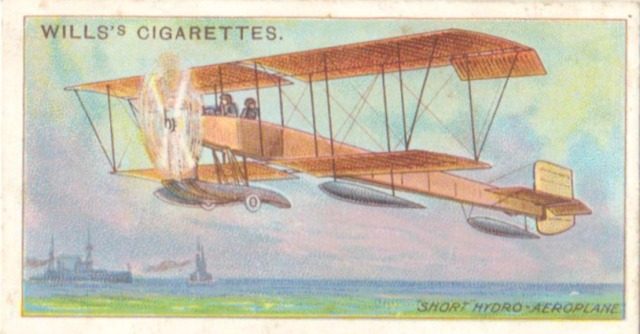 History Behind The Card: “Short” Hydro-Aeroplane.
History Behind The Card: “Short” Hydro-Aeroplane.
Card #78 of 85, W.D.& H.O Wills, Aviation series 1912, Vice Regal Mixture – Black-back issue
- Horace Leonard Short on July 2, 1872 in Chilton Colliery, Durham, England, Great Britain – April 6, 1917 at Parsonage Farm, Eastchurch, Isle of Sheppey, Great Britain;
- Air Commodore Charles Rumney Samson, July 8, 1883 in Crumpsall, Manchester, England, Great Britain – February 5, 1931 in Salisbury, Wiltshire, England, Great Britain.
- Albert Eustace Short on June XX, 1875 in Chilton Colliery, Durham, England, Great Britain – April 8, in 1932 at Medway, Rochester, Kent, England, Great Britain.
- Hugh Oswald Short in January 16, 1883 in Stanton by Dale, England, Great Britain – in December 4, 1969 at Gillham’s Farm, Lynchmere, West Sussex, England, Great Britain.
We are at the point where I do not own the cards pretty much from this point on through #85… as such, there won’t be a reverse image of the cards forthcoming.
First off, let me just say that information on the internet on the Short Brothers is crap, filled with half information and half misinformation. It’s so frustrating, that it makes me not want to do this.
So much information from different sources, and little of it fills in enough blanks to get a complete story… the first time I have come across this in 78 Wills’s cards. Bah.
For example, sites talk about the Short Brothers becoming the first airplane production company because of an order for six aircraft they were building based on a legal license from the Wright Brothers. Great. Were they built? Did they fly? What the heck was their designation?
I’ve looked and looked… and it’s all crap. It’s very frustrating. People who do have the information on the family simply aren’t very good in telling the whole story. Which makes my non-paying job here… what’s the word… nigh-on impossible.
Hells… even trying to determine the aircraft on the front of this card… heck… it’s a determination/guess.
This card depicts the Short Hydro-Aeroplane, designed and built by the Short Brothers… and while Wills’s card calls the aeroplane by a generic name, I believe it actually depicts the Short S.27 or the Short Improved S.27, which sometimes goes by the name of the Short-Sommer biplane.
The aircraft were used by the Admiralty and Naval Wing of the British Royal Flying Corps for training the Royal Navy’s first pilots, as well as for early naval aviation experiments.
An improved S.27 was used by Charles Rumney Samson to make the first successful take-off from a moving ship on May 9, 1912… which is why he gets a mention at the top of this blog.
The Short Brothers were a threesome featuring Horace, Eustace and Oswald – who were Britain’s first aircraft manufacturers, designing and building the first British-powered aircraft to complete a circular flight of one mile.
They also created Britain’s first-ever purpose-built aircraft factory on an aerodrome on the Isle of Sheppey, Kent, England.
While not on everyone’s lips when it comes to aviation pioneers, the company Short Brothers plc, (aka Shorts or Short) was founded in London in 1908 and is considered to be the first company in the world to manufacture production aircraft.
The company still exists, but as part of other aviation companies, purchased in 1989 by Bombardier in Belfast, Norther Ireland, producing aircraft components, engine nacelles and aircraft flight control systems for Bombardier Aerospace, as well as for Boeing, Rolls-Royce Deutschland, General Electric and Pratt & Whitney.

From left: Oswald, Horace and Eustace Short
Let’s take a look at just who the Short Brothers were.
Of the three, Horace was the eldest. When he was an infant, he suffered a head injury, with it leading to a bacterial infection and then full on meningitis.
This in turn led to an abnormal brain development that gave him an differently-shaped head, and for whatever reason, he also seemed to have a genius intellect. The oddly shaped head made him look ferocious according to some media. But that’s all conjecture. He looked like he looked, as far as I am concerned.

On leaving school at the age of 16, Horace was employed at the Stanton Ironworks, but in 1890 after two years there, he set off to see the world and visit his uncle William, who had moved to Australia and was responsible for sinking the first of two shafts at Newcastle, New South Wales.
Arriving in Australia, Horace wrote home and told the family of his global adventures, but was unaware that his father had died in 1891 leaving the family broke.
A local Chesterfield newspaper published the letter from Horace in 1893 to establish a fund to allow brother Eustace the opportunity to find Horace.
They finally managed to meet in Mexico in 1894 where Horace was now managing a silver mine.
In 1895, Eustace returned to England with £500 and a promise from Horace that he would follow as soon as he could wind up his affairs.
With that money given to him by Horace, brothers Eustace and Oswald, along with their mother moved to London and bought a coal merchant business.
In 1896 Horace traveled back to England bringing with him a sound-amplifying device that he had invented and wished to patent.
Brothers Oswald and Eustace started up the Short Brothers company in 1897 when they purchased a used coal gas-filled balloon, with the intention to develop and construct other such balloons.
But, in 1900 after they visited the 1900 Paris Exposition World’s Fair, they saw the balloons of Édouard Surcouf who was working with Société Astra, taking note of his truly spherical balloons, a method that had been, up until then, a pipe dream.
The Short Brothers then began to determine how to manufacture spherical hot air balloons themselves, offering up their version in 1902.
These balloons were manufactured in a building where brother Horace was working in Sussex. On the main floor, Horace worked in an acoustic lab and was trying to perfect his acoustic amplifier with a European agent of Thomas Edison, while Oswald and Eustace built balloons on the second floor.
By 1903, Horace was onto a new project involving the development of a steam turbine, and left the building, which caused Eustace and Oswald to move the Short Brothers company first to a rented place in London and then to the railway arches in Battersea, which was situated next to the Battersea gas-works…. making it easier to get gas for their balloons.
The Short Brothers made a few balloons here and there, but got their big break i n1905 when they were awarded a contract from the British Indian Army who wanted three balloons.
The balloons impressed Royal Balloon Factory superintendent Colonel James Templer, who introduced the Short Brothers (sans Horace) to Charles Rolls.
Yup… the guy who later co-founded the Rolls-Royce automobile company.
Rolls asked the Short Brothers to build a large balloon so he could take part in the 1906 Gordon Bennett balloon race. The race (aka Coupe Aéronautique Gordon Bennett), was started from Paris, France, on September 30, 1906, and is still run today. It is considered to be the oldest and most prestigious balloon race.
The race was sponsored by James Gordon Bennett, Jr., the millionaire sportsman and owner of the New York Herald newspaper. The contest rules to fly the furthest distance from the launch site without landing.
The contest ran from 1906 to 1938, interrupted by World War I and in 1931, but was suspended in 1939 when the hosts, Poland, were invaded at the start of World War II.
The event was only started up again in 1979 American Tom Heinsheimer, an atmospheric physicist, gained permission from the holders to host the trophy. The competition was not officially reinstated by the Fédération Aéronautique Internationale (FAI) until 1983.
Rolls, along with wine merchant Frank Hedges Buttler, were the founding fathers of the Aero Club of Great Britain (now the Royal Aero Club).
Thanks to Rolls, other members of the Aero Club of Great Britain soon placed orders with the Short Brothers.
Rolls, by the way, was the first Briton to be killed in an aeronautical accident with a powered aircraft, when the tail of his Wright Flyer broke off during a flying display on July 12, 1910.
But what of super genius Horace?
Horace felt that ballooning was dangerous because one couldn’t steer it properly, so he continued to work with the Hon. Charles Pearson on steam turbine development.
By 1907, and with evidence that aeroplanes were now the new girl on the block, the Short Brothers tried their hand at building them for the Aero Club of Great Britain members, but always without success.
Background: While the Wright Brothers (and witnesses) say they first flew in December of 1903, they kept their success a secret. But when Alberto Santos-Dumont flew his independently built aeroplane on October 23, 1906, the cat was out of the Wright Brothers’ bag.
Everyone wanted an aeroplane.
While the Wright Brothers had tried to sell their invention the the U.S. military, rather than the general public, until Santos-Dunont’s flight the Wright Brothers had been fairly secretive. They had a contract for the sale of airplanes to a French syndicate as well as to the U.S. Army.
Wilbur Wright took their revised Wright Flyer which now had a second seat for a passenger, to Europe to try and garner interest and sales.
Still, aviation was not being shared, so the technology had to independently gleaned by designers.
On January 13, 1908, Henry Farman flew his Voisin Farman I in a one-kilometer circle to win the 50,000-franc Deutsche-Archdeacon prize.
The Canadian company the Aerial Experiment Association–founded by Canadians Alexander Graham Bell (yes, the telephone inventor), Casey Baldwin and J.A.D. McCurdy, along with two Americans, Lt. Thomas Selfridge of the U.S. Army and Glenn Curtiss–flew three different aeroplanes during the summer of 1908: You should read my article on that HERE. Suffice to say, their June Bug flew one mile in one minute and 42.5 seconds on July 4, 1908, giving the AEA the Scientific American Trophy.
The Wright Brothers, I can tell you, were jealous.
So… when Wilbur Wright arrived in France in 1908 with his aircraft and gave demonstration and passenger flights from a site near Le Mans.
Upon hearing about these successful flights, Eustace and Oswald Short decided to give up ballooning and to start building aircraft, but they realized that they would need Horace in the new venture.
When Horace was released from his contract Pearson, the Short Brothers in December of 1908 became a true Short Brothers aviation company with each investing 200 pounds Sterling to get the new aeroplane company off the ground.
Horace, perhaps because of his brains, was immediately becoming the chief aeroplane designer for the company, and with that, the Short Brothers became the world’s first commercial aviation company to design and manufacture aeroplanes.
Their first aeroplane was to be the Short No. 1…

The Short No. 1
As mentioned… everyone wanted an aeroplane. After seeing the Wright Brother’s demonstration at Le Mans, France, Brit Francis McClean asked Horace Short to build him a plane.
So, in November of 1908, Horace began to design his Short No. 1, a three-bay biplane with a biplane elevator and central fin mounted on two pairs of converging booms in front.
The undercarriage used skids, rather than wheels, made from ash, that extended forward almost as far as the elevators. Since no wheels were included – just the skids – the aircraft was expected to launch using a launching rail the same way the Wright Brothers did with their first flying machine.
Excluding the skids, everything else was made of spruce and covered with a rubberized fabric made by German company Continental AG.
The engine was to be a version of the Wright Bros.’s engine made by Bariquand et Marre, that drove a pair of pusher propellers, mounted slightly above mid-gap using a chain drive. This was arranged so that both propellers revolved in the same direction, since crossing them to make them revolve in opposite directions might have infringed patents held by the Wright brothers.
But, while the plane was ready at the Short Brothers’ factory on the Isle of Sheppey, when McClean arrived back in town after visiting China, the engine they wanted from Bariquand et Marre was not yet built.
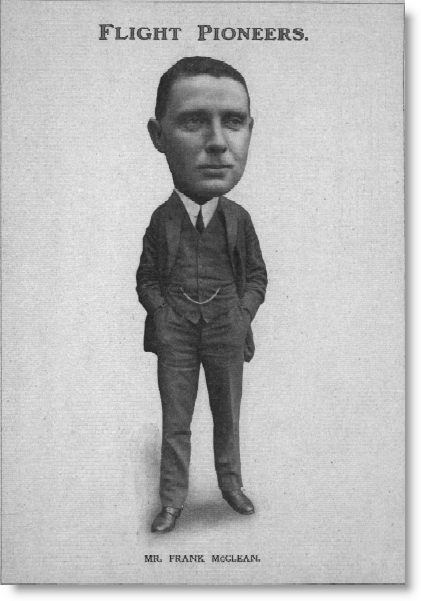
Francis McClean in a caricature done by Flight Magazine December 1909.
Not wanting to delay the aircraft for McClean, the Short Brothers took a 30 horsepower engine from a Nordenfelt car, and installed it in their aeroplane.
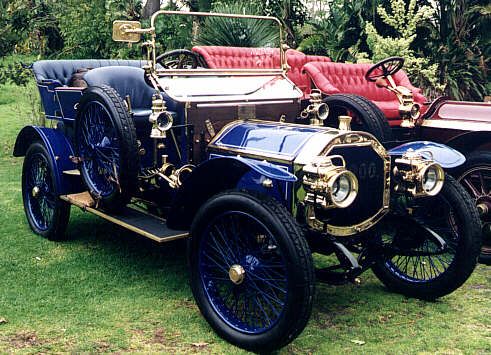
This is a 1907 Nordenfelt auto – the only one left in the world.
But, being a car engine, it was a heavy engine at 270 kilograms (600 pounds), and led to the aircraft failing its initial test flight in September of 1909. It was so heavy, that it couldn’t even move the aircraft to the end of the launching rail.
Nordenfelt, was a British auto manufacturer from 1906-1909… and while physical evidence still exists of a 1907 model, I can’t find an image of one from 1908 (but data shows it was built) or a 1909. By this time, it is possible they were no longer building cars – just motors.
Soon enough, the proper Bariquand et Marre engine arrived in October of 1909.
With McClean as the pilot, three test flights were made on November 2, 3, and 6 of 1909.
The last attempt almost had the aircraft become airborne, but as McClean applied the full up-elevator, the bird stalled and fell back onto the launching rail and broke its undercarriage and propellers.
Although McClean was not hurt, all involved agreed to not continue with the development of the Short No. 1.
Specifications of Short No. 1
- Crew: one;
- Length: 24 feet 7 inches (7.49 meters);
- Wingspan: 40 feet (12 meters);
- Wing area: 576 square feet (53.5 square meters);
- Gross weight: 1,200 pounds (544 kilograms);
- Powerplant: 1 × Bariquand et Marre 4-cylinder inline water-cooled, 30 horsepower
- Propellers: 2-bladed laminated spruce made by Short Brothers at 10 feet (3.0 meters) diameter
When You’re Right, You’re Wright
As for the Wright Brothers… after they met Charles Rolls who had traveled to the U.S. to sell his automobiles, the Wright’s were also looking for someone to build their Wright Model A for them in the Great Britain.
Rolls knew the Short Brothers, and so… the Short Brothers, because of the nice balloon work they had done for Rolls, were recommended (and accepted) to build the Wright aeroplanes in Great Britain.
Now… while Wilbur Wright had no drawings of his aircraft to supply to the Short Brothers, Eustace Short had a look at the Wright Model A, and created his own drawings.
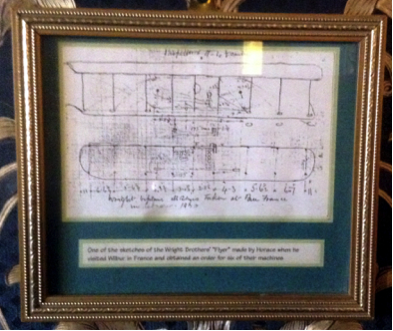
A drawing by Eustace Short of the Wright Brother’s Wright Model A aeroplane from which the licensed Wright aeroplanes were built. http://shortbrothersaviationpioneers.co.uk/1898-1917/4592622025
Great… so was there any special designation given to the aircraft? How come the Wright Brothers couldn’t be bothered to provide drawings of their own aircraft to the Short Brothers?
Who at the Aero Club bought the aircraft? Did they fly well? If so, these would have been the first successful aeroplanes built by the Short Brothers – something of great import… but no… there’s nothing celebrating this achievement… this factory order that put the company in the history books…
Short No. 2
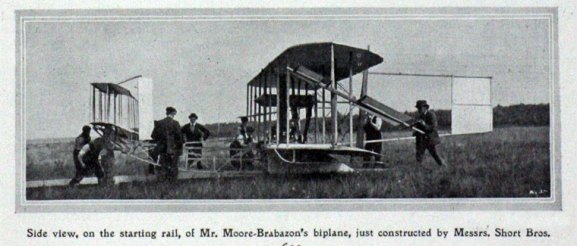
So… with the failure of the Short No. 1, and having the order to build the Wright Model A licensed aircraft for six members of the Aero Club, we know that the Short Brothers have an order for another airplane of its own design… the Short No. 2, requested in April of 1909 before they realized that Short No. 1 was a failure.
The Short No. 2 aircraft was requested by J.T.C. Moore-Brabazon, who wanted to use this unproven flying machine to win a £1,000 prize offered by the British Daily Mail newspaper for the first closed-circuit flight of over a mile (1.6 kilometers) to be made in a British aircraft.
Moore-Brabazon had previously learned to fly in 1908 in France in a Voisin biplane.
He became the first resident Englishman to make an officially recognized aeroplane flight in England on May 2, 1909, at Shellbeach on the Isle of Sheppey with flights of 450 feet (137.2 meters), 600 feet (182.9 meters), and 1,500 feet (457.2 meters) using the Voisin biplane named the Bird of Passage.
Below, there’s a very cool photograph taken on May 4, 1909 outside the Aero Club clubhouse known as Muswell Manor – take a look and see some of the early greats of aviation…

May 4, 1909 at Muswell Manor is a veritable who’s who of aviation pioneer greatness! Back Row (L-R): JDF Andrews owner of Muswell Manor, Oswald Short, Horace Short, Eustace Short, Francis McClean, Griffith Brewer, Frank Butler, WJS Lockyer, Warwick Wright. Front Row (L-R): JTC Moore-Brabazon, Wilbur Wright, Orville Wright, Charles Rolls.
After taking delivery of one of the Short Brother’s built Wright Model A aircraft, Moore-Brabazon sold his famous Bird of Passage aircraft to Arthur Edward George in 1909.
He waited a while longer before the Short Brothers completed their Short No. 2, but on October 30, 1909, he flew that aeroplane in a circular mile to win the Daily Mail prize of £1,000.
Despite the high pedigree of Moore-Brabazon, he was a man with a sense of humor.
To prove once and for all that a pig could fly, he placed a piglet in a waster-paper basket and tied it to a wing-strut on the Short No. 2, and flew it up into the air on November 4, 1909… which, quite possibly, was the first-ever live cargo air flight.
On January 7, 1910, Short No. 2 was flown by Moore-Brabazon a distance of 4.5 miles from Shellbeach to the Royal Aero Club’s new flying field at Eastchurch, by which time a revised tail consisting of elongated fixed horizontal and vertical surfaces carried on four booms had been fitted to improve stability.
It was now Moore-Brabazon’s intention to make an attempt to win the British Empire Michelin Cup, and on March 1, 1910 he made a flight covering 19 miles (31 kilometers) in 31 minutes – but he was forced to land after the crankshaft broke.
A new engine was fitted, but he did not fly the plane for a while, as the Short No. 2 was to be exhibited at the Aero Exhibition at Olympia…
He didn’t fly it again until March 25, 1910… even so, no one else came close to besting his flight’s distance and so was awarded the Michelin Cup.
On March 8, 1910, Moore-Brabazon became the first person to qualify as a pilot in Great Britain, earning the Royal Aero Club Aviator’s Certificate No. 1.
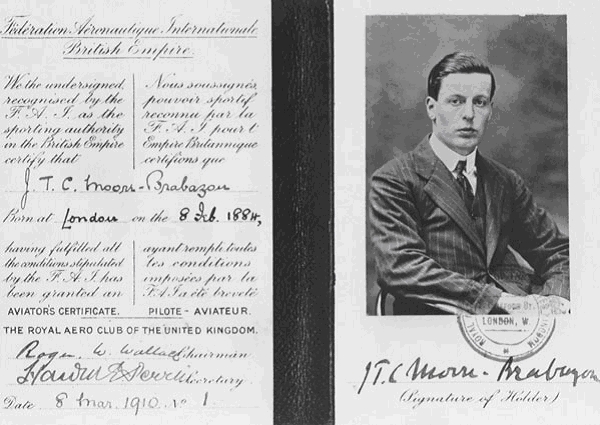
The very first Aero Club license awarded to J.T.C. Moore-Brabazon on March 8, 1910.
So why… why was there never a singular Wills’s aviation tobacco card devoted to the accomplishments of Moore-Brabazon – a Brit, after all?
By the time the Aero Exhibition was taking place in March of 1910, Moore-Brabazon had ordered another aircraft from the Short Brothers – the Short S.27.
As for our man Charles Rolls… we know he purchased one of the six Wright Brothers’ Model A’s built by the Short Brothers, liking it enough to have used it in over 200 flights.
On June 2, 1910, Rolls became the first person to fly a non-stop double crossing of the English Channel, doing so in 95 minutes. It was also the first East-bound crossing of the Channel – but big whoop.
While the Rolls name lives on famously in automobile history, it lives on in rather dubious fashion in aviation.
Flying his Wright Model A, on July 12, 1910, Charles Rolls became the first British person to be killed in aeroplane – 11th in the world, if you are keeping track. Lt. Thomas Selfridge (an American) had died while a passenger aboard a Wright Flyer piloted by Orville Wright on September 17, 1908 to become the first aeroplane casualty.

Charles Rolls
For Rolls, while flying, the tail of the aeroplane broke off in the Southbourne district of Bournemouth at Hengistbury Airfield. He was 32.
With the death of Rolls, the wife of his friend Moore-Brabazon convinced her husband to stop flying – and so he did.
I have searched and searched, but ca not find a photo of the Short No. 2 aeroplane.
Specifications of Short No. 2
- Crew: one;
- Length: 32 feet (9.75 meters);
- Wingspan: 48 feet 8 inches (14.83 meters);
- Wing area: 450 square feet (42 square meters);
- Gross weight: 1,485 pounds (674 kilograms);
- Powerplant: 1 × Green D.4 in-line 4-cylinder water-cooled, 60 horsepower;
- Propellers: 2-bladed;
- Maximum speed: 45 miles per hour (72 kilometers per hour).
Short S.27

In May of 1910, the Short Brothers began to build four aircraft known as S.26, S.27, S.28 and S.29.
These four aircraft were designed by Eustace Short and were based on the Farman III, a pusher biplane.
Short S.26 was built for Francis McClean and utilized a Green engine capable of 40 horsepower.
The very same engine type was also in S.28, an aeroplane built for JTC Moore-Brabazon.
Short S.27 used an ENV type F engine with 60 horsepower for Cecil Grace.
The Short S.29 was built by the company as a reserve.
All four of these aircraft became known as the S.27 design because owner Cecil Grace flew it at many aviation events.
The main difference between the aircraft beside the motor, involve the Green engines having a single rudder under the tailplane, while the ENV engine on the S.27 (proper) had an additional rudder mounted above it.
The standard undercarriage of this design had two wheels attached to an axle that was attached to the skids.
How good were the aircraft – which is what I believe is the basis for the Wills’s card at the very top?
Well, on June 20, 1910, Cecil Grace flew his S.27 (proper) to a height of 1,180 feet (360 meters) which was a new British altitude record.
At the Midland Aero Club meeting at Wolverhampton – June 27 – July 2, 1910 – Grace stayed in the air for close to 30 minutes reaching a height of 500 feet (150 meters) – both respectable times and altitudes for the era.
So successful was this S.27 design, that the Short Brothers improved on the basic design almost immediately, creating the S.27 Improved version, which had strut-braced extensions on the top wings which made for a greater wingspan (now 12 feet 3 inches (3.73 meters), as well as a stronger wing structure, and a reduced span front elevator without the sections outboard of the booms.
These improved aircraft used a Gnome rotary engine at either 50 or 70 horsepower, and were numbered all the way up to S.44.
Short S.27 Improved Specifications
- Crew: two;
- Length: 42 feet 1 inches (12.83 meters);
- Wingspan: 46 feet 5 inches (14.15 meters);
- Wing area: 517 square feet (48.0 square meters);
- Empty weight: 1,100 pounds (499 kilograms);
- Gross weight: 1,540 pounds (699 kilograms);
- Powerplant: 1 × Gnome Omega 7-cylinder air-cooled rotary engine, 50 horsepower;
- Maximum speed: 48 miles per hour (77 kilometers per hour).
I’m going to shorten up the history lesson here. In 1919, the Short partnership was incorporated as Short Brothers (Rochester and Bedford) Limited – coach builders – with Eustace Short as joint managing director until his death in 1932, and Oswald Short its chairman and joint managing director.
In 1919, nationalization ended the Short Brothers’ involvement with the airship company, which became the Royal Airship Works.
In 1933, the company once again became involved in aviation with construction of aeroplanes, seaplanes and flying boats for civil and military purposes.
In 1936 Short Brothers (Rochester and Bedford) and Harland and Wolff agreed to form a new company to build aircraft in Belfast, Ireland, with the Short Brothers being the majority stakeholder. The company was called Short and Harland.
In 1938 they built their Short-Mayo composite aircraft, which took part on July 20 as the first heavier-than-air commercial crossing of the North Atlantic as Imperial Airways‘ Short S20 floatplane G-ADHJ. It covered 2,930 miles in 20 hours and 20 minutes.
1947 Decided to concentrate its activities at Belfast. Short and Harland Ltd changed their name to Short Brothers and Harland and decide to acquire parts of Short Brothers (Rochester and Bedford) which was then liquidated. Oswald Short became President fro life of the new company.
Its construction of aircraft continued.
In the 1960s, the company produced turboprop airlines and components for aerospace primary manufacturers, and missiles for the British Armed Forces.
In 1989, the company was purchased by Bombardier. The owner was: HM Government, 69.5% (majority share); Rolls-Royce Ltd, 15.25%; Harland & Wolff Ltd, 15.25%.
Rolls-Royce? It goes around.
Nowadays, as a subsidiary of Bombardier Aerospace, what was once the Short Brothers continues to construct aircraft components, engine nacelles and aircraft flight control systems for Bombardier, as well as Boeing, General Electric, Pratt & Whitney, and… yes, Rolls-Royce Deutshland.

Pingback: Wills’s Aviation Card #80–”Short” Biplane. | Pioneers Of Aviation
Pingback: Checklist For Wills’s Cigarettes Aviation 1911 – 85-Card Series – soon to be updated | Pioneers Of Aviation